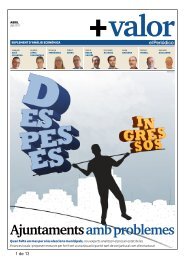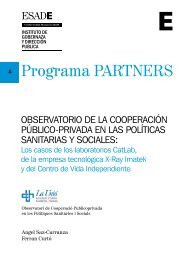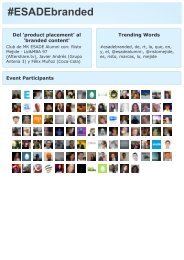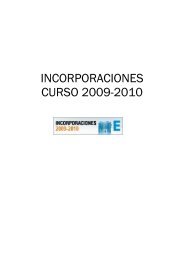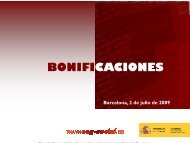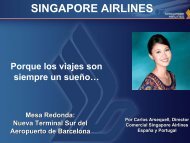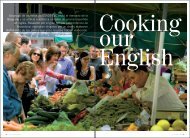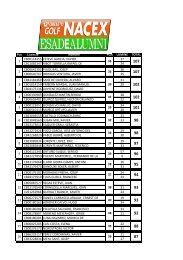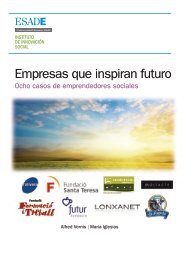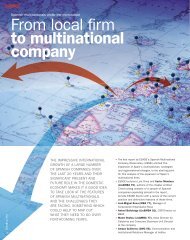PhD in Management Sciences Seminar Open Innovation - Esade
PhD in Management Sciences Seminar Open Innovation - Esade
PhD in Management Sciences Seminar Open Innovation - Esade
You also want an ePaper? Increase the reach of your titles
YUMPU automatically turns print PDFs into web optimized ePapers that Google loves.
<strong>PhD</strong> <strong>in</strong> <strong>Management</strong> <strong>Sciences</strong> Sem<strong>in</strong>ar<br />
<strong>Open</strong> <strong>Innovation</strong> & <strong>Open</strong> Bus<strong>in</strong>ess Models<br />
Program overview<br />
Henry Chesbrough<br />
Haas School of <strong>Management</strong> - UC Berkeley & ESADE<br />
Wim Vanhaverbeke<br />
Hasselt U., ESADE & National U. of S<strong>in</strong>gapore<br />
We welcome you to what promises to be a most <strong>in</strong>tensive, excit<strong>in</strong>g<br />
<strong>in</strong>tellectual experience. We have both written extensively on the topic<br />
of <strong>Open</strong> <strong>Innovation</strong> (which we will def<strong>in</strong>e carefully dur<strong>in</strong>g the Course),<br />
but we believe that the best work <strong>in</strong> this area is yet to come! We have<br />
selected some read<strong>in</strong>gs and chapters to guide you <strong>in</strong> prepar<strong>in</strong>g for our<br />
two day Course. You will get much more out of the Course if you make<br />
the time to put more <strong>in</strong>to it. Please read the assigned material<br />
carefully, and come prepared to share your questions, reflections and<br />
criticisms with us and your colleagues. Furthermore, upon registration<br />
participants should submit an abstract (1-2 pages) as well as br<strong>in</strong>g a<br />
poster (A2 format) of their current or <strong>in</strong>dented <strong>PhD</strong> research on open<br />
<strong>in</strong>novation to be discussed with faculty and Ph.D. candidates.<br />
We have also <strong>in</strong>corporated reasonably long breaks and lunches, so we<br />
hope that you’ll have time to get to know us and each other. While the<br />
<strong>Open</strong> <strong>Innovation</strong> research community is grow<strong>in</strong>g, it rema<strong>in</strong>s at an early<br />
stage of development. Your passion, commitment, energy and ideas<br />
are vitally needed. Once aga<strong>in</strong>, welcome!<br />
Day 1: Monday, January 7, 2013<br />
Welcome by Jonathan Wareham<br />
Short <strong>in</strong>troduction of each participant<br />
9.00 AM -9:30 AM<br />
Session 1: Explor<strong>in</strong>g <strong>Open</strong> <strong>Innovation</strong> as a theoretical concept<br />
9.30 AM -11:00 PM<br />
Coord<strong>in</strong>ated by Henry Chesbrough<br />
Read<strong>in</strong>gs:<br />
1) <strong>Open</strong> <strong>Innovation</strong>: Research<strong>in</strong>g a New Paradigm (Chesbrough,<br />
Vanhaverbeke and West, OUP, 2006): Chapters 1,2<br />
2) Joel West and Marcel Bogers (2010), An Integrated View of<br />
Creat<strong>in</strong>g and Commercializ<strong>in</strong>g <strong>Innovation</strong>: A Distributed<br />
Perspective, unpublished paper.<br />
Assignment Questions:<br />
1) What IS “open <strong>in</strong>novation”? What is its precise def<strong>in</strong>ition?<br />
School:<br />
ESADE Bus<strong>in</strong>ess School<br />
Barcelona - Sant Cugat Campus<br />
Date:<br />
Time<br />
ECTS: 3<br />
January 7-11, 2013<br />
9:00 – 12:30 h.<br />
14:00 – 20:00 h.<br />
Language: English<br />
Participants max: 30<br />
Participants m<strong>in</strong>: 5<br />
Structure:<br />
Module 1: Theory (Review <strong>Open</strong><br />
<strong>Innovation</strong>)<br />
Module2: Practical (Present<br />
research proposals)<br />
Fee :<br />
Full sem<strong>in</strong>ar: 800€<br />
Reduced price: 500€ *<br />
*(<strong>PhD</strong> candidates who already<br />
took the course, and they are<br />
just <strong>in</strong>terested on module 2)<br />
Special fee for CEMS / EDAMBA<br />
Enrolment deadl<strong>in</strong>e:<br />
December 21 , 2012<br />
Applications to:<br />
http://apps.esade.edu/saw/start<br />
.do?pys=2597573&idi=en<br />
Contact <strong>in</strong>formation:<br />
Ms.Pilar Gállego<br />
pilar.gallego@esade.edu<br />
About ESADE <strong>PhD</strong>:<br />
http://www.esade.edu/web/eng<br />
/programs/management/phd<br />
1
2) Has <strong>in</strong>novation always been open? Why or why not? What has changed <strong>in</strong> the past thirty<br />
years, if anyth<strong>in</strong>g?<br />
3) What role does the bus<strong>in</strong>ess model play <strong>in</strong> <strong>in</strong>novation? What is the def<strong>in</strong>ition of “bus<strong>in</strong>ess<br />
model”?<br />
4) What evidence supports the emergence of open <strong>in</strong>novation? How conv<strong>in</strong>c<strong>in</strong>g is this evidence<br />
to you?<br />
5) In Chapter 5, West and Bogers discuss open source software? Is open source an example of<br />
open <strong>in</strong>novation? Why or why not?<br />
6) How could you test this theory?<br />
7) How to extend open <strong>in</strong>novation <strong>in</strong>to new application areas?<br />
Session 2: Analyz<strong>in</strong>g the research methodology two recent open <strong>in</strong>novation papers / articles<br />
11.30 AM – 12.30 PM<br />
Coord<strong>in</strong>ated by Wim Vanhaverbeke<br />
We pick 2 recent papers that cover quite different areas, and we will show how the research design<br />
was done, how open <strong>in</strong>novation was measured, and what the paper contributes to the literature.<br />
How the limitations of the articles can be tackled by future research.<br />
Read<strong>in</strong>gs:<br />
1) Laursen, K. and Salter, A. (2006), <strong>Open</strong> for <strong>in</strong>novation: The role of openness <strong>in</strong> expla<strong>in</strong><strong>in</strong>g<br />
<strong>in</strong>novation performance among U.K. manufactur<strong>in</strong>g firms. Strategic management Journal, 27,<br />
131-150.<br />
2) Von Krogh, G. Wall<strong>in</strong>, M.W and Sieg J.H (2012); A problem <strong>in</strong> becom<strong>in</strong>g: How firms formulate<br />
sharable problems for <strong>in</strong>novation contests, Work<strong>in</strong>g paper presented at the <strong>Open</strong> <strong>Innovation</strong><br />
conference, Imperial College, London, June 23-24, 2012.<br />
Session 3: Explor<strong>in</strong>g How to write papers and manage the thesis writ<strong>in</strong>g process<br />
0.30 PM -1:30 PM<br />
Coord<strong>in</strong>ated by Wim Vanhaverbeke<br />
Lunch: 1:30 PM -2:30 PM<br />
Session 4: Connect<strong>in</strong>g open <strong>in</strong>novation to theories of the firm<br />
2.30 PM – 4.00 PM<br />
Coord<strong>in</strong>ated by Henry Chesbrough<br />
Read<strong>in</strong>gs<br />
1) <strong>Open</strong> <strong>Innovation</strong>: Research<strong>in</strong>g a New Paradigm (Chesbrough, Vanhaverbeke and West, OUP,<br />
2006): Chapters 1,2,3, and 5<br />
2) Vanhaverbeke, W. and Cloodt, M. (2011); L<strong>in</strong>k<strong>in</strong>g open <strong>in</strong>novation to different theories of the<br />
firm, unpublished paper. (this paper can be read <strong>in</strong> comb<strong>in</strong>ation with Vanhaverbeke, W., Van<br />
de Vrande, V. and Chesbrough, H. (2007), Understand<strong>in</strong>g the Advantages of open <strong>in</strong>novation<br />
practices <strong>in</strong> corporate ventur<strong>in</strong>g <strong>in</strong> terms of real options, Creativity and <strong>Innovation</strong><br />
<strong>Management</strong>, 17(4), 251-258.<br />
Assignment Questions<br />
1) Accord<strong>in</strong>g to Chesbrough’s argument <strong>in</strong> Chapter 1, what is new about open <strong>in</strong>novation?<br />
What does it contribute to the literature?<br />
2
2) J.F. Christensen’s chapter (chapter 3) situates open <strong>in</strong>novation <strong>in</strong> the prior literature on the<br />
firm, how the firm appropriates a return on its <strong>in</strong>novation <strong>in</strong>vestments, and bus<strong>in</strong>ess<br />
strategy. What is your evaluation of his argument?<br />
3) In the same chapter, Christensen refers to open <strong>in</strong>novation as an organizational <strong>in</strong>novation.<br />
Do you agree? Why or why not?<br />
4) Take one theoretical approach expla<strong>in</strong>ed <strong>in</strong> Vanhaverbeke, Roijakkers & Cloodt and check<br />
whether you can further strengthen or criticize the arguments? Which theories of the firm<br />
have not received enough attention <strong>in</strong> your op<strong>in</strong>ion?<br />
5) In Chapter 2, Chesbrough details five themes for connect<strong>in</strong>g the chapters he previews to the<br />
larger literature on bus<strong>in</strong>ess:<br />
a. The bus<strong>in</strong>ess model<br />
b. Us<strong>in</strong>g external technology<br />
c. Manag<strong>in</strong>g knowledge<br />
d. The role of startups and new entrants<br />
e. Intellectual property<br />
f. What would you add to this list?<br />
Session 4: Explanation of the groups work<br />
4.30 PM -5.30 PM<br />
Coord<strong>in</strong>ated by Henry Chesbrough and Wim Vanhaverbeke<br />
Each participant has submitted an overview of his/her <strong>PhD</strong> proposal when he / she registered for the<br />
course. These one page leaflets, which are exposed <strong>in</strong> the room, should give the participants an<br />
accurate picture of the ongo<strong>in</strong>g <strong>PhD</strong> work <strong>in</strong> Europe. Can we f<strong>in</strong>d commonalities? Can we group<br />
participants <strong>in</strong> groups of 5 or 6. “The future of open <strong>in</strong>novation research” is the general theme for<br />
the group works, but we want to ensure that each group works on a particular topic that is more or<br />
less <strong>in</strong> l<strong>in</strong>e with their own research. Each group will present its conclusions <strong>in</strong> session 4 of day 2.<br />
Group work<br />
5.30 PM – 8.00 PM<br />
Coach<strong>in</strong>g by Henry Chesbrough, Esteve Almirall, Alberto Di M<strong>in</strong><strong>in</strong>, Wim Vanhaverbeke and Albert<br />
Armisen<br />
D<strong>in</strong>ner: 8.00 PM – 10.00 PM<br />
Day 2: Tuesday, January 8, 2013<br />
Session 1: Critical views on and limits of open <strong>in</strong>novation<br />
09.00 AM -10.30 AM<br />
Coord<strong>in</strong>ated by Henry Chesbrough<br />
Read<strong>in</strong>gs<br />
1) Paul Trott & Dap Hartmann (2009); Why ‘<strong>Open</strong> <strong>Innovation</strong>’ is old w<strong>in</strong>e <strong>in</strong> new bottles,<br />
International Journal of <strong>Innovation</strong> <strong>Management</strong>, 3 (4), 715-736.<br />
2) Elmquist M., Fredberg T. and Ollila S., (2009): Explor<strong>in</strong>g the field of open <strong>in</strong>novation,<br />
European Journal of <strong>Innovation</strong> <strong>Management</strong>, 12(3):326-345.<br />
3) Dahlander, L. and Gann, D.M. (2010), How open is <strong>in</strong>novation, Research Policy, 39, 699-709.<br />
4) <strong>Open</strong> <strong>Innovation</strong>: Research<strong>in</strong>g a New Paradigm, chapter 1 (this was assigned yesterday as<br />
well. Read it this time for the antecedents Chesbrough, Vanhaverbeke and West cite, and<br />
what they argue is new).<br />
Assignment Questions:<br />
1) Could you add anyth<strong>in</strong>g really new about open <strong>in</strong>novation, or not?<br />
3
2) Reread your notes from yesterday’s discussions, <strong>in</strong> light of the Trott-Hartmann critique. Do<br />
you see any ways to reconcile that critique with what you’ve learned about open <strong>in</strong>novation?<br />
3) What are the limits of open <strong>in</strong>novation? When might it fail, and why?<br />
Session 2: Recent Research (especially empirical research) <strong>in</strong> the area of open <strong>in</strong>novation<br />
11.00 AM – 12.30 AM<br />
Coord<strong>in</strong>ated by Wim Vanhaverbeke<br />
Have a look at the abstracts of the burgeon<strong>in</strong>g number of academic articles about open <strong>in</strong>novation<br />
(you can use Google Scholar or surf to Exnovate (www.exnovate.org) :<br />
First author’s name A-I<br />
First author’s name J-R<br />
First author’s name S-Z<br />
Assignment Questions:<br />
1) How open <strong>in</strong>novation can be empirically tested? What are the different possible quantitative<br />
and qualitative methods?<br />
2) Can you expla<strong>in</strong> why some of these methods are scarce? Are there any possibilities to<br />
circumvent or remove these obstacles?<br />
3) Given the different empirical research methods, what are the major opportunities for <strong>PhD</strong><br />
students to develop brand new research <strong>in</strong> the open <strong>in</strong>novation area? How would you start<br />
this research?<br />
Session 3: The future of <strong>Open</strong> <strong>Innovation</strong> research?<br />
2.00 PM – 6.30 PM<br />
Coord<strong>in</strong>ated by Henry Chesbrough & Wim Vanhaverbeke<br />
Students present the research theme they have been prepar<strong>in</strong>g dur<strong>in</strong>g the two days. We organize<br />
sessions with two groups. Each group has 25 m<strong>in</strong>utes to present, followed by 10 m<strong>in</strong>utes discussion<br />
by the other group. F<strong>in</strong>ally, we have 10 m<strong>in</strong>utes a general Q&A per group.<br />
Group 1: 2.00 PM – 2.45 PM<br />
Group 2: 2.45 PM – 3.30 PM<br />
Break : 3.30 PM – 3.45 PM<br />
Group 3: 3.45 PM – 4.30 PM<br />
Group 4: 4.30 PM – 5.15 PM<br />
Break : 5.15 PM – 5.30 PM<br />
Summary of the “future of open <strong>in</strong>novation research” by the group mentors:<br />
5.30 PM – 6.15 PM<br />
Wrap up & general discussion of the 2 days: 6.15 PM – 6.45 PM<br />
Farewell D<strong>in</strong>ner: 8.30 PM - …<br />
4
Day 3: Wednesday, January 9, 2013<br />
Dur<strong>in</strong>g the third day we offer participants who are writ<strong>in</strong>g (papers for) their <strong>PhD</strong>-thesis, the<br />
opportunity to present a research paper. All submissions should be sent to<br />
wim.vanhaverbeke@esade.edu before December 21, 2012. You can only send a full version of the<br />
paper. Extended abstracts will not be accepted.<br />
We will group similar presentations <strong>in</strong>to panels of 3 students, with one discussant. Each student<br />
presents for 15 m<strong>in</strong>utes, the discussant presents for 10 m<strong>in</strong>utes, and then general Q&A. Other<br />
participants who have not yet f<strong>in</strong>alized papers for their <strong>PhD</strong>-thesis can attend these sessions and<br />
learn valuable lessons about research paper writ<strong>in</strong>g. Students that present can save their Powerpo<strong>in</strong>t<br />
Presentation on a USB stick. A computer is available <strong>in</strong> the classroom.<br />
Papers will be discussed by Henry Chesbrough (UC-Berkeley & ESADE), Bruno Cassiman (IESE,<br />
Barcelona), Christoph Zott (IESE, Barcelona), Alberto Di M<strong>in</strong><strong>in</strong> (Scuola Superiore Sant'Anna, Pisa) and<br />
Wim Vanhaverbeke (UHasselt & ESADE).<br />
Session 1: Paper discussions (round 1)*<br />
9.00 AM -10.30 AM<br />
Break : 10.30-11.00<br />
Session 2: Paper discussions (round 2)*<br />
11.00 AM -12.30 AM<br />
Note: * The schedule may be adapted depend<strong>in</strong>g on the number of submissions.<br />
Wrap up session:<br />
12:30AM – 1.00 PM<br />
General conclusions, summariz<strong>in</strong>g action po<strong>in</strong>ts, suggestions for next year’s sem<strong>in</strong>ar.<br />
Farewell lunch:<br />
1.00 PM – 2.00 PM.<br />
About the organizers:<br />
Prof. Dr. Henry Chesbrough is Executive Director of the Center for <strong>Open</strong> <strong>Innovation</strong> at UC Berkeley’s<br />
Haas School of Bus<strong>in</strong>ess. He is also Professor of Information Systems at ESADE Bus<strong>in</strong>ess School. He is<br />
the author of <strong>Open</strong> <strong>Innovation</strong> (HBS Press, 2003), <strong>Open</strong> Bus<strong>in</strong>ess Models (also HBS Press, 2006),<br />
<strong>Open</strong> <strong>Innovation</strong>: Research<strong>in</strong>g a New Paradigm (Oxford, 2006) and <strong>Open</strong> Services: Reth<strong>in</strong>k<strong>in</strong>g Your<br />
Bus<strong>in</strong>ess to Grow and Compete <strong>in</strong> a New Era (Jossey Bass, 2011). He was previously Assistant<br />
Professor and 1961 Fellow at Harvard Bus<strong>in</strong>ess School. He holds a Ph.D. from U.C. Berkeley <strong>in</strong><br />
Bus<strong>in</strong>ess and Public Policy, an MBA from Stanford, and a BA from Yale.<br />
Prof Dr. Wim Vanhaverbeke is professor at the University of Hasselt. He is also Visit<strong>in</strong>g Professor at<br />
the ESADE Bus<strong>in</strong>ess School and the National university of S<strong>in</strong>gapore. He has published <strong>in</strong> numerous<br />
<strong>in</strong>ternational journals and is co-editor with Henry Chesbrough and Joel West of “<strong>Open</strong> <strong>Innovation</strong>:<br />
Research<strong>in</strong>g a New Paradigm”. He is extend<strong>in</strong>g research about <strong>Open</strong> <strong>Innovation</strong> and open bus<strong>in</strong>ess<br />
models by sett<strong>in</strong>g up Exnovate and by do<strong>in</strong>g jo<strong>in</strong>t research with different universities around the<br />
globe.<br />
5




